Introduction
Snapshots
Waves of Refugees, Generations of Synagogues
Synagogue Architecture: Three Case-Studies
Conclusion
Introduction
In 2003 UNESCO ratified the “Convention for the Safeguarding of the Intangible Cultural Heritage,” defined as a set of practices, representations, and expressions that communities recognise as vital for their culture. In the matter of Intangible Cultural Heritage, a specific area of investigation concerns some lost urban landmarks that keep arousing a broad public and scholarly interest.
This is precisely the case of Salonika’s lost synagogues.
In January 2013 the local Jewish Museum inaugurated the exhibition entitled A city in search of its kehilot; invisible cultural monuments of Salonika. Based on new research material, the curator Dr. Evangelos Hekimoglou encouraged visitors to recognize the exact location of a number of historical synagogues, thus gaining knowledge of the “layers of the past” underlying the central business district and the present image of the city.
Today, on reaching Salonika, planes will often fly over the historic center, still partly surrounded by its Byzantine walls. The roads parallel to the coast are clearly visible, as is Aristotelous Street, the main feature of the reconstruction which gave the Greek government an opportunity to reshape the city. A Civic Axis originally meant to concentrating institutional buildings, Aristotelous Street was built over an area which had been home to the Jewish quarter for four hundred years.
BACK
Snapshots
The lost late-Ottoman city
In the final decades of the 19th century Salonika was the second most important Ottoman city. After the Tanzimat(1839-76), a period of institutional and social reforms aimed at modernizing the Empire while furthering its multicultural nature, non-Muslims and non-Turks became more thoroughly integrated into Ottoman society and were granted new civil rights.1 Described as a “bazaar-city,”2 Salonika was also known as the “Jerusalem of the Balkans” for its predominantly Jewish population,3 often the subject of comment by travelers:
“I notify to the lovers of ethnography this interesting experience: a sort of Jewish nation left on its own under the most tolerant of despotisms, and forming the majority of a great cosmopolitan city.”4
“Salonika is neither Greek nor Ottoman; it is rather a Jewish city, a sort of Jerusalem.”5
“All the boatman of the port are Jews, and on Saturdays no steamer can load or discharge cargo. Porters and shoeblacks, bricklayers and silk-hands, are all Jews.”6
Ottoman reforms had encouraged the Salonika Jews to reorganize the community along secular lines and under secular leaders, many of whom were playing a leading part in the city’s economic revival, fostered by port and railway works (1886-1904). In 1886, half of its 90,000-100,000 inhabitants were Jews, a quarter were Muslims and the rest Orthodox and Europeans;7 most of Salonika’s banks and trading houses were in Jewish hands. In 1912, after being fought over by Turks, Greeks, Bulgarians and Serbians, Salonika was incorporated into the Greek State. Despite the unease created over the new situation, the Jewish presence remained an essential component of the city.8 According to the first Greek census of 1913, the Jews numbered 61,439 (38.9%), the Muslims 45,867 (29.1%), the Greeks 39,936 (25.3%), and people of other origins 10,600 (6.7%), making a total of 157,889 inhabitants.9
Any traveler wishing to understand the contradictions of a city, fraught between tradition and innovation, could look to the port and business district in the old Frank quarter. Banks and entertainment venues, commercial agencies and insurance companies, hotels and passages à la Français, stood next to the old hans10 and the “sacred precincts” belonging to the main religious legations: the Protestant Chapel, the Catholic Church with the French Consulate, and the St. Menas Greek-Orthodox church. Farther on, Frank Street led through the Jewish neighborhoods with their array of historic synagogues.
In August 1917 Ottoman Salonika - with its mosaic of ethno-religious neighborhoods - was destroyed by fire.
“The market was little else than an enormous brazier, the Jewish quarter a memory. The Bank of Athens, the National Bank, and the Ottoman Bank were in ashes. The whole ruthless district of commerce, trusts, hoarding and plunder sank into the burning ash like biblical cities.”11
The fire destroyed more than 30 synagogues whose names had borne witness to the provenance of their communities: Ashkenaz, Provence, Italy, Sicily, Spain, Castile, Catalonia, Aragon, Majorca, Lisbon, Portugal, Evora, Calabria, and Puglia. [Fig.1]

Ernest Hebrard’s “Civic Axis” superimposed onto previous urban pattern
(Reconstruction by C. Pallini)
The lost synagogues
All scholars remark on the gravity of this loss12 and agree on one point: the Jews of Salonika formed a federation of small, independent communities, each with its own language, traditions, and liturgy, each synagogue expressing a tangible sign of autonomy and playing a poleogenetic role in fostering settlement and cohesion of the social edifice.
The term poleogenetic13 refers to settlement processes at the origin urban life. These may range from migratory movements to new behavioral patterns, particularly in “fringe areas” where the boundary between a consolidated built environment and new forms of settlement is constantly and contradictorily being redefined. In this perspective, architecture may be interpreted as a basic expression of civilization, catering for primary needs of the populations concerned.
How then, the fact that the Jews of Salonika formed “a federation of communities” was reflected in architecture? Considering their different origins, might it be that, seen as a whole, their historic synagogues represented varying expressions of Jewish art? Or might this have been the case originally, seeing that the synagogues had several times been rebuilt on account of frequent fires in the city?
The Jews recreated 15th century Spain in Salonika14 but, due to restrictions imposed by the Ottoman authorities as to site and size, in the 19th century their synagogues were limited to simple rectangular halls, often in side roads concealed from public view, in no way comparable to the Mudéjar-style structures of Toledo, Cordoba, and Segovia.15
Travelers’ descriptions agree on this point. The French missionary Jean-Baptiste Souciet, who visited Salonika in 1734, wrote that the Jews had at least thirty synagogues, some quite big and all the others badly built and “located along the streets.”16 The German Paul Lindau (1888) noted that, though very powerful, the Jewish community had no synagogue striking for its grandeur or its architectural value. The historian and archaeologist Oreste Tafrali (1910-11) considered the monuments of Salonika’s Jewish community as insignificant. The French traveler Marius Bernard (1913) observed that no traces of the old Arab-style synagogues were left in Salonika, and that none of them had preserved its original form; he described them as low, rectangular, severely simple buildings, except for recently-built examples which embodied features of oriental architecture.17
The lost synagogues in their urban contexts are of particular significance for an understanding of whether or not any forms of settlement and architectural expression can be attributed to the Sephardi Jews.18 These synagogues may have held important clues to explain the evolution of three different types: the prayer hall on the first floor with the heikhal19 and tevah20 facing each other at the east-west ends of a wide aisle;21 the prayer hall on the ground floor and the interior divided into a number of bays by columns supporting arches; and the interior divided by four columns grouped roughly in the center of the room to include the tevah.22 With every building destroyed, any surviving photographic material is of fundamental importance, such as travel descriptions, maps of the city before the fire or hypothetical maps locating the synagogues.23 Following this line of thought, an attempt has here been made to cross-check available sources (including experiments with representation techniques) primarily focusing on the late-15th century synagogues built by refugees from Spain and Portugal and, secondly, on early-20th century synagogues, where the question of “style” assumed particular importance. The three case-studies focus on the central synagogue: the Talmud Torah (1520-1917), the Beth Saul (1917-1943), the Monastirioton (1943-present day).
BACK
Waves of Refugees, Generations of Synagogues
Salonika Jews before the Ottoman conquest
It is believed that the first Jews reached Macedonia in the days of Darius I (513 B.C.E.), followed by others during the Persian Wars (480 B.C.E.).24 Salonika was founded around 315 B.C.E. by Cassander who had assumed control of Macedonia after Alexander’s death.25 To form the city, inhabitants of twenty-six small towns and villages at the head of the Thermaic gulf were relocated where the foothills of Mt. Chortiatis reach the sea and the wide coastal plain, and where the southernmost route from the Adriatic Sea across the Balkan peninsula meets the north-south corridor along the Morava-Vardar valleys.
From 145 to 135 B.C.E new waves of Jewish refugees arrived from Alexandria and Palestine;26 in the first century the autochthonous inhabitants lived alongside the Alexandrians and others of the same religion from nearby Amphipolis and Apollonia: Greek was their common language and their main religious building was the Etz Haim (Tree of Life) synagogue, whose location and foundation date is still debated.27 When, between 1168 and 1173, Benjamin of Tudela stopped at Salonika on his way to Jerusalem, he found many Greek Jews (Romaniotes) there, as well as small communities of Italian and Sicilian Jews.28
The synagogues of Salonika can be grouped by generations, each reflecting a fresh wave of refugees. [Fig. 2]

It is still doubtful whether the Ashkenaz synagogue (also named Varnak or Synagogue of Nuremberg) dates back to 1376 or to 1470-75. During this 100-year period Jews had continued to arrive: from Freiburg, Speyer, Strasbourg, Worms, Frankfurt, Mainz (1348-59, the years of the Black Death); from Hungary (expelled in 1376); Austria (expelled in 1420-21); Cologne (1424); Swabia, Rhein, Steiermark, Moravia and Hungary (1430);30 Strasbourg (1438); Ausburg (1440); Erfurt (1458); Bavaria (1470).31 The synagogue named Provencia – a term then indicating a cultural area covering southern France from the Garonne to the Alps – was established in 1394 by Jews expelled from France by Charles VIII.32
Once a flourishing center of trade where merchants from Venice, Genoa, Pisa, Ancona, Bari and Trani had their quarters and/or businesses,33 in the early 15th century Salonika experienced the turbulence that preceded the actual end of the Byzantine Empire. Following occupation by Venice (1423-30), when the city was all but an island in an Ottoman sea, many Jews from Sicily and Venice moved there and built the Sicilia and Italia synagogues.
These Jewish groups had little in common. Greek Jews, for the most part espoused traditions based on the Palestinian Talmud, while the European Jews generally followed the Babylonian Talmud.34 The Romaniotes spoke Greek, the Ashkenazi Jews spoke Yiddish, the Provence Jews French and the Italians spoke various forms of that language; Italian and Provençal Jews had little difficulty over integration though this was not so for the Romaniotes and Ashkenazim.35
Thessaloniki morphing into Selanik
On March 29, 1430 Sultan Murat II took possession of Salonika, the great military base of the Byzantine emperors. Situated at the end of the Thermaic gulf, easily accessible from inside the Balkan Peninsular and Central Europe, the city also lay on the Via Egnatia, connecting the Adriatic to Constantinople.36 Following years of war, depopulation and impoverishment, Salonika was almost deserted and the harbor no longer in use. With a view to restoring life to the city, Murat II seized houses from the townsfolk to find shelter for the Greek and Turkish colonists then arriving.37 The first Ottoman census carried out in central Macedonia (1478) showed that all the Jews of Salonika had been forcibly moved to Constantinople in the wake of the city’s conquest (1453); these same documents bear evidence to a mixed settlement pattern, with twenty-seven new Muslim communities partly occupying each of the ten pre-existing Christian quarters.38
A greater change, however, occurred with the arrival of Jews expelled from Spain and Portugal following edicts promulgated by the Roman Catholic Monarchs in 1492 and 1496.39 Salonika at that time had only a small population: a handful of Greeks, the Turkish garrison and some Turkish families from nearby Yannitza, a small colony of merchants from Venice and Marseilles, and two or three thousand Jews. 40
At midnight on August 2, 1492, when Columbus embarked on his expedition to the New World, his fleet departed from the relatively unknown seaport of Palos as the shipping lanes of Cadiz and Seville were encumbered with Sephardi Jews expelled from Spain. During their journey they had been told that the Sultan would allow them entry: this massive immigration of Sephardim provided Sultan Bayezid II with an opportunity to bring Jews back to the cities41 from where they had been deported by his father Murat II.42
“Towards the end of the summer of 1492, on approaching the coast of the Thermaic gulf, crowded on the decks of their ships, they passed alongside the dark mass of the Great Cape, leaving the snow-capped peaks of Mount Olympus on their left and the muddy delta beyond which the silver ribbon of the Vardar stretches back into the plain. From within the gulf they entered a bay that seemed like a quiet lake. With avid eyes they sought the promised city.”43
The number of exiles disembarking in Salonika was initially very small but increased progressively in the following years with new arrivals from Sicily and Southern Italy (1493), Calabria (1497), Portugal (1497), Provence (1497) and Puglia (1502).
The Ottoman census taken in 1519 reported a population of 29,000, and showed that over a period of 41 years, during which it tripled, nearly 54% of Salonika’s inhabitants were Jews.44 Between 1493 and 1536 over 20,000 Jews and Marranos45 poured into the city.
Settlement patterns
Scholars from many disciplines,46 have frequently commented on the “religious pluralism” of the Ottoman Empire, explaining how the relationship between the Muslim ruling class and non-Muslim communities was regulated by the millet system,47 according to which the “People of the Book” (non-Muslim adherents to faiths which have a revealed scripture, namely Greek Orthodox, Jews, Armenians, Syrian Orthodox, and Catholics) were granted a fairly high margin of freedom and administrative autonomy. Within this framework, confessional communities acted as one entity in terms of taxation and were collectively responsible for administering law and establishing their own welfare and educational institutions. Even if the Jewish millet was formally recognized as late as 1835, Jews enjoyed de facto privileges similar to the Greek-Orthodox population, and were directly represented by the Chief Rabbi (Hakham Bashi) who held wide legislative powers for enforcing the laws governing their presence in the Empire.
The millet system was somehow reflected in the urban topography of most Ottoman cities, each being a mosaic of mahalle – districts of established residents, each with a religious building and community institutions, administrative units governed by a Muhtar. Although Salonika underwent dramatic changes following the Ottoman conquest48 and massive immigration of Sephardim, the city nevertheless retained its Hellenistic structure featuring main roads set at right angles to mark off and link the three main ethno-religious quarters, each one facing onto the Via Egnatia.49 [Fig.3]
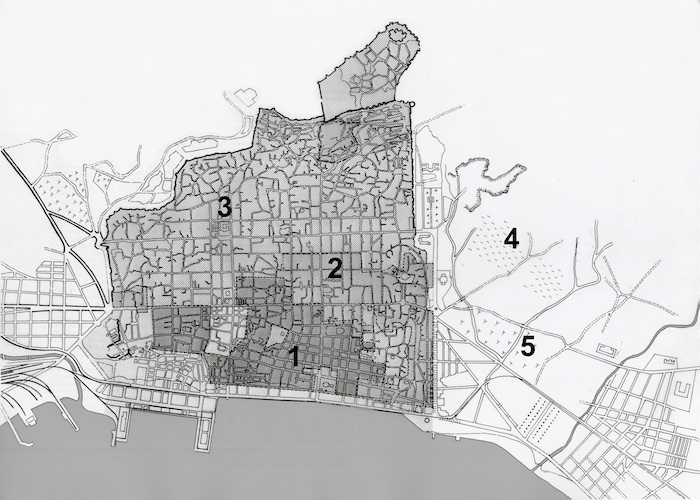
(Drawing by C. Pallini)
While Greeks assembled in the south-eastern area of the Hippodrome and the Palace of Galerius, and Turks occupied the upper town, the Jews were concentrated in the partially-deserted lower town adjacent to the port and market areas.51
This initial separation among the congregations became attenuated over time during a slow process of permeation and alteration to boundaries, while the chief community institutions of the original group based close to the market remained consistent.
According to Joseph Nehama, Gilles Veinstein and Argyres Petronitis the Jewish master builders introduced and established in Salonika and other Macedonian cities the Toledo-style house with an interior patio or cortijo around which the spare, simple dwellings were built.52 The Jewish districts therefore featured inner courtyards where most of the daily activities were conducted:
“In olden days, The Jews of Salonika lived in houses which surrounded large courtyards called cortijos. The houses formed a kind of square around the courtyard. Facing the courtyard were open galleries, with roofs held up by wooden pillars. At the back were the living quarters with small grilled windows overlooking the street. (…) Each house would give refuge to a family comprised of many souls (…) To house these new generations it was necessary to construct room after room, reducing the size of the courtyard with new extensions, and sometimes even to overflow into the street. (…) The Jewish dwellings always had a modest and inexpressive exterior, sometimes even a shabby look. The cortijos were not completely devoid of foliage and fig trees, pomegranate trees, vines and jujube trees gave welcome shade during the warm summer. In the spring, jasmine and roses emitted a delicious perfume which permeated the air.”53 [Fig.4 / Fig.5]


The poleogenetic role of synagogues
The Jews who arrived from the Iberian Peninsula found there the old Romaniote synagogue Etz Haim and the more recent synagogues Askhenaz, Italia and Sicilia. Those who had originally come from Spain considered themselves more civilized and refined than the other immigrants and were inclined to remain aloof. They came from many areas and, like the Italian Jews, tended to group together by home town, city, or area of origin. Thus new Jewish communities became established and new synagogues were founded: Gerush Sefarad (Expelled from Spain), Castilia, Catalan, Aragon and Mayor(Majorca). Others were founded by Portuguese Jews (Portugal, 1497 or 1525; Lisbon, 1510; Evora, 1512 or 1535) and by Jews from Calabria (Calabria, 1497) and Southern Italy (Puglia, 1502). The 1519 survey reports the 16 Jewish neighborhoods54 that recreated 15th-century Spain in Salonika.
The high intellectual level of the Sephardim resulted in cultural and economic revival. The city and its port acquired fresh life from the manufacturing activities initiated by the new arrivals. Of these activities weaving later became an established industry55 and soon of interest to the state. The Jews were especially skilled in wool spinning, an industry imported from Spain which spread to all localities around the Thermaic Gulf. Having once been granted the right to obtain raw materials at less than market prices and the exclusive rights to produce the fine woollen cloth used for garments worn by the Janissaries (1578), Salonika was soon swarming with telares (textile workshops); each terrace and each cortijos had its workshop: the whole city functioned like a huge spinning factory, dripping with water that gushed from under the door-sills and painted its streets in a variety of colours.
In the Salonika of the 16th century Jewish communities functioned like little “states” inside the city, diverse in language, rites, traditions and cultures, their respective synagogues expressing a tangible sign of autonomy. In this mosaic of cité synagogales56 the various Jewish congregations shared a self-determined body of laws covering religious and social issues (e.g. how new settlers were to be divided among existing congregations, how the Marranos were to be treated and how commercial activities were to be directed).57 Led by a Rabbi (a role which in many cases passed from father to son) and guided by the Assembly (attended only by those who paid community taxes), the synagogue acted as the soul of each group and formed the core of each neighborhood, the focal point in public celebrations and daily toil, business, haste. For immigrants it was a corner of “home.” To preserve the customs and rituals peculiar to their respective congregations, each synagogue had its own school, library and a seminary for higher studies, a philanthropic foundation and a burial society. The synagogue functioned as a center for administration of the law and the economy; butchers, bakeries and dairies were nearby, all supplying food in the way required by the Jewish religion.
When visiting Salonika in the mid-16th century, the French geographer Nicolas de Nicolay mentioned eighty synagogues,58 all of which had until then maintained their individual identities. Each synagogue was at one and the same time a religious and a civic structure, a historical and cultural landmark, a fundamental element of the “sentimental topography” shared by all members of the community. When a synagogue was destroyed by fire it was rebuilt on the same sacred site. 59
BACK
Synagogue Architecture: Three Case-Studies
A question still unsolved
Can any form of settlement, building type or stylistic feature be attributed to the Sephardi Jews? When presenting the proceedings of an international meeting on Sephardi architecture, Petruccioli raised this point.60 Since, as we know, the Sephardi language and culture remained alive longer than those of other Jewish groups, we could assume that their imprint was preserved in the form and features of Ottoman cities in cases of gradual assimilation. This would particularly apply to Salonika, where the Sephardim formed the largest ethnic group and where Sephardi culture and economic influence were most firmly established. Architecture, however, still had a marginal role in Jewish culture, and Jews had always adapted themselves to a variety of architectural and constructional traditions in different contexts, especially in the Ottoman cities where the distribution of trades among ethnic groups clearly marked Jewish indifference towards the art of building (or that builders’ guilds were closed to the Jews).61
Having emphasized the importance of the relationship between the heikhal, the tevah and the minimum space for the congregation in the prayer hall, Nitzan-Shiftan62 explains how the synagogue of Spanish rite changed from a basilica-type layout to a single hall, and to the four-column type in particular (an adaptation to forms of local architecture), recalling that, in the Sephardi liturgical tradition, the bifocal space between heikhal and tevah had been adapted to the plan of the basilica, creating the four-column type in the smaller synagogues. This layout, with the tevah in the center, was the most common in the Ottoman Sephardi synagogues which, in most cases, included the school and refectory both inside a walled courtyard (cortijos). These considerations are echoed by Messinas, who refers to published sources who connect the Mudéjar style to the early Salonika synagogues.63 In Greek cities under Ottoman rule (as also in Venice, Ferrara or Izmir) their external aspect differed little from neighboring houses, and followed the basilica-type plan.64 According to Thalia Mantopoulou-Panagiotopoulou, the absence of monuments belonging to Salonika’s Jewish community should not be ascribed to a lack of architectural tradition, but rather to the harsh circumstances of Ottoman rule.65
Nehama wrote that the first temples built by the Jews who arrived from the Iberian Peninsula –Gerush Sefarad (the very first), Catalan, and Lisbon – included “architectural embellishment” recalling the synagogues of Toledo, Cordoba and Lisbon, adding that all four Portuguese synagogues featured a highly elaborate interior decoration.66
Established by the Jews from Aragon and Galicia, the Aragon synagogue67 was the largest and richest in town until the early 18th century; comprising a circular courtyard, it was laid out so that one part of the congregation stood on the spacious tevah, another next to the heikhal and a third at the center of the prayer hall, surrounded by wooden columns.68 The Catalan synagogue was established by refugees from Catalonia, mostly from Barcelona and Girona. It may be added that the Provencia synagogue was one of the most significant, and the Italia synagogue was located next to a source of water known as the Madresika del Agua (mother of waters).
The Anglo-Jewish author and historian Elkan Nathan Adler said, on visiting the historic synagogues of Salonika in 1898:
“I arrived in Salonica on Friday, the 23d September, 1898, and attended the synagogue on Sabbath (…) Most characteristic is the marble flooring in these Schools. The seats are movable benches and sometimes chairs. The Sicilians possess quite gorgeous purple or crimson armchairs (…). But each form is but the evidence that years ago the Salonicans, like the Persians of today, squatted on the ground as they prayed. Accommodation for the female synagogue-goers was none too abundant. The galleries, or corners reserved for them, are scrupulously trellised or curtained off from the indiscrete gaze of opposite sex. They were just like the shelters provided for the Harem beauties in the theatre boxes at Cairo. (…) Of all the synagogues that of Aragon seemed the most picturesque. It is large, and the Almemar is a lofty dais at the extreme west end, gallery high. The Ark is also highly placed and many elders sit on either side on a somewhat lower platform. Italia was most striking, for the synagogue is but half-built, the floor not yet bricked in, and the galleries of rough lathes, and yet the women climbed up the giddy steps on the scaffolding, and the hall was full of worshippers. The sacred appurtenances were borrowed from diverse Chevras, and, of course, there were lots of lofty thirty-hour candles.”69
This description is integrated with photographs of the Catalan and the Talmud Torah synagogues in ruins after the fire of 1890: strongly built square piers without capitals linked by Islamic ogee arches, which were decorated with a cornice in the form of a recessed arch. These rubble masonry structures were very similar to public buildings erected by the Ottomans soon after the conquest. [Fig.5]
The following is an attempt to describe the three central synagogues of Salonika, namely the Talmud Torah (1520-1917), the Beth Saul (1917-1943) and the Monastirioton (from 1943 onwards).
The multi-purpose Talmud Torah
According to E.N. Adler the lost Talmud Torah synagogue was “one of the most ancient and authentic of the community.”70 Any city or town of importance in the Ottoman Empire had its own Talmud Torah (I am taught the Law), but none was equal to that of Salonika.
“Here it represents l’œuvre des œuvres, the glory of all the synagogues, under constant care. (…) It was a town hall, a temple, a school complex, an hostelry and a center for philanthropy. In the 16th century the Talmud Torah had to cater for multiple and varied collective needs, growing progressively as the institution concentrated all vital forces of the Jewish population of Salonika.”71
The establishment of the Talmud Torah in 1520 (whose council, which included members from other synagogues, changed every three years), marked the beginning of a “federal policy” aimed at promoting cultural unification of Jewish communities.72 Education was the raison d’être of the new institution; while primary schools were also attended by orphans and children of the poor, its secondary school was the best in Salonika by the end of the 17th century. A symbol of the unity of the Jews, the Talmud Torah provided lodging for travelers and a soup kitchen, as well as handling the release of Jewish prisoners and receiving and re-homing refugees.73
During the golden age of Sephardism (1536-93),74 when Salonika became a textile center, the Talmud Torah was also equipped for textile manufacture, functioning as a permanent market/meeting place for artisans and for workers seeking employment.
Initially consisting of makeshift buildings, the Talmud Torah “microcosm” was destroyed and rebuilt many times. A depiction of a festival celebrationshows the interior as a “messy caravanserai resembling a noisy fairground”75 still in existence before the reforms of 1884.
“It was built in the Arabic style, with a large square building on two floors, and it opened up to an interior courtyard. (…) The first floor was the prayer house. It consisted of a large corridor, a kind of gallery open to sun and wind, and enclosed by a balustrade. 26 pillars, corresponding to the numerical value of the name of God, Yahveh, held up the roof, forming a series of arcades around to the patio. It was here that the faithful would come together during the services. For the congregation, there were graduated benches in the form of an amphitheater along the four sides of the patio. If there were a large gathering, the patio itself would be used. The ground floor was not open to the central patio. In this large hall there were benches where the classes were organized, but no divisions between them. It was in this hall that people came to hear the decision of the rabbinical council in matters concerning the Jewish community.” 76
Visiting Salonika around the mid-17th century, the Turkish scholar and writer Kâtib Çelebi suggested visiting the Talmud Torah as it housed many libraries and was staffed by over 200 teachers, as well as having approximately one thousand pupils, from children to adult men. The Scottish traveler William Lithgow (1609) wrote that Salonika had been converted into a university for the Jews where the Jewish clergy was educated to be sent to different cities.77
The metamorphosis of the Talmud Torah took place towards the end of the 19th century, alongside the westernization and economic development of Salonika, a process largely led by the Jewish community. Following an educational reform promoted by the local Alliance Israélite Universelle,78 the Talmud Torah complex was reorganized in 1880 and partly rebuilt in 1884:
“30 classrooms opening onto a corridor were built around a vast courtyard. A smaller building was set up to offer lodging to homeless people and travelers who were passing through.”
In 1898 the Talmud Torah complex was again destroyed by fire, and rebuilt with the help of many donors (1899-1904). The new synagogue was praised by Joseph Klausner (1910) for its ample size and fine colonnades:
“Though different from European synagogues, the result is wonderful. Here is the oriental atmosphere and originality, holiness but also simplicity.” 79
The newspaper L’Indépendant (1915) stated that this was the largest synagogue built by the Salonika Jews since their expulsion from Spain, and was also the most significant in the city in terms of both size and architecture.80 The rectangular central hall, 38 meters long, 24 meters wide and with 14 meter high ceilings, was surrounded by a portico with arches and columns of Tuscan marble; the balcony of the women’s gallery ran the length of the walls.81 The entrance led straight onto the tevah, also of marble, that extended towards the center of the hall. The Talmud Torah, a complex of 1600m2, had its own courtyard around which the schools and chief community institutions were built.
“Here beat the heart of the Jewish community; this explains why the Turkish Baths was called Yahudi Hammam, even if it was mostly used by the Turks.”82
The seat of the Arch-Rabbinate, the Jewish market, the ambulatory of the Bikour Holim foundation (1888) and the gymnasium of the Maccabi athletic club, founded in 1908, were all close by. The schools of the Alliance Israélite Universelle (Eli Modiano, 1908-10), where young Jews were educated according to French culture, lay a few blocks to the south along a road parallel to Frank Street.83 Research carried out by Evangelos Hekimoglou shows that the plot of the Talmud Torah, was the greatest one of intra-muros city. Extending for 4,200m2 at the core of the Jewish quarter, the Talmud Torah complex included a number of synagogues and internal yards, a school and an asylum, as well as the bakery for unleavened bread.84 [Fig.6 / Fig.7]
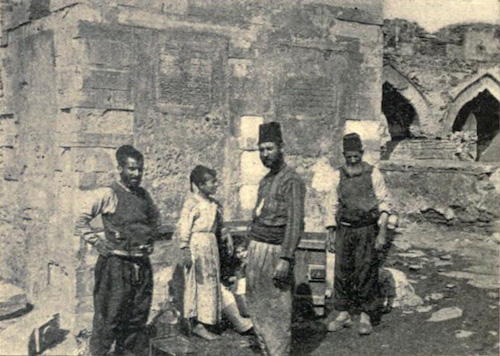
Philadelphia, The Jewish Publication Society of America, 1905), 144.
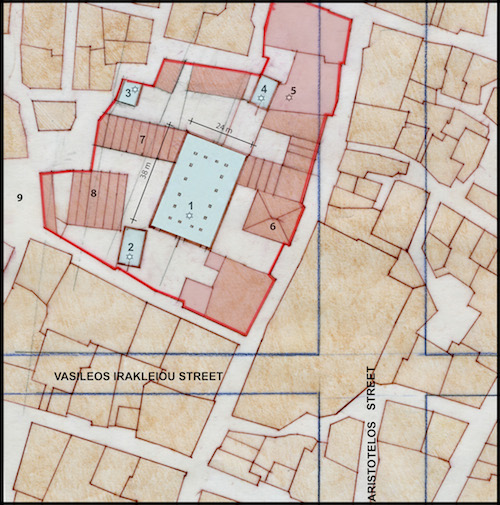
based of material shown in the panels of the exhibition A city in search of its kehilot;
invisible cultural monuments of Salonika). Aerial photos taken after the fire of
August 1917 show that most buildings forming the Talmud Torah complex were still standing.89
The Beth Saul synagogue
The Beth Saul synagogue was established in 1898 by Fakima Modiano in memory of her husband Saul, one of the leading figures in the city’s economic growth of the 19th century, whose activities ranged from international trade to banking, while constantly supporting community schools and institutions.85 Saul Modiano (1817-1883) was a Francos, a Jew whose ancestors had taken refuge in the port of Livorno during the exodus from Spain, moving to Salonika halfway through the 17th century; Francos were not subjects of the Ottoman Empire and therefore enjoyed the favorable regime of capitulations.86
The synagogue was designed by the Italian architect Vitaliano Poselli87 who at that time was also working on reconstruction of the Catholic church in Frank Street (1897-1900). A few years later Poselli was to build the new mosque for the Dönmehs88 (1902) and the Armenian church (1903).
Poselli was sent to Salonika by the Ottoman government, to design state-sponsored buildings which were to ‘cloth in stone’ the major reforms: clearly visible from various viewpoints and combining principles of symmetry and regularity, these western-inspired structures were to give a progressive modern aura to a centuries-old city.
While the earlier synagogues were modest structures along blind alleys, or placed in upstairs rooms, but always an integral part of the urban fabric including auxiliary spaces and community institutions, the Beth Saul stood alone in a garden next to the new family mansion (Villa Ida, V. Poselli, 1886-90).
Built for private use inside a private estate, the synagogue was oriented with its main facade towards the Avenue des Campagnes, but was quite distant from the public eye.
Running parallel to the coast road outside the eastern walls, this road served the Hamidiye district: a specifically Levantine suburb “similar to the Island of the Princes at Istanbul,”90 where the most luxurious villas and a number of consulates were to be found, and where the traditional separation by religion and ethnic provenance had come to an end. [Fig.8 / Fig.9]
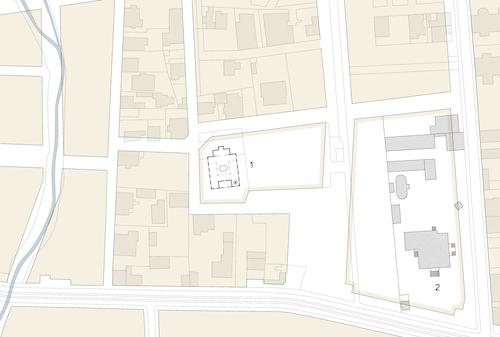
Drawing by A. Scaccabarozzi based on a 1925 map published in V. Colonas and
L. Papamatthaiakis, The Architect Vitaliano Poselli – His Work in Thessaloniki, 80.
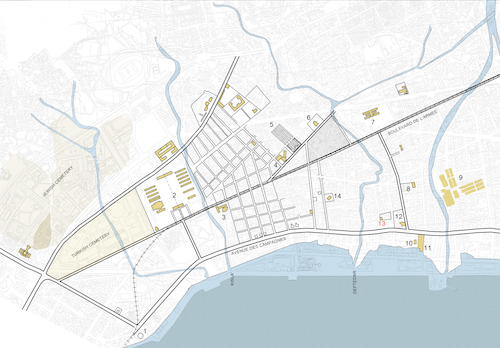
(Authors’ reconstruction).92
The Beth Saul synagogue was a western-inspired building marking a clear break with the past. 91 Its main facade was characterized by side bays and a central section with a curved gable at the top of which stood the Ten Commandments carved in marble. With its horizontal bipartition, round-headed and circular windows alternating with strips of Tuscan pilaster, the exterior combined elements of Romanesque and Neoclassical architecture, clearly revealing the inner layout: a three-aisled prayer hall with a women’s gallery above the entrance and side aisles; a generous space accommodated the heikhal and the deep platform in front of it, adjacent to which was the elaborately decorated tevah.[Fig.10]
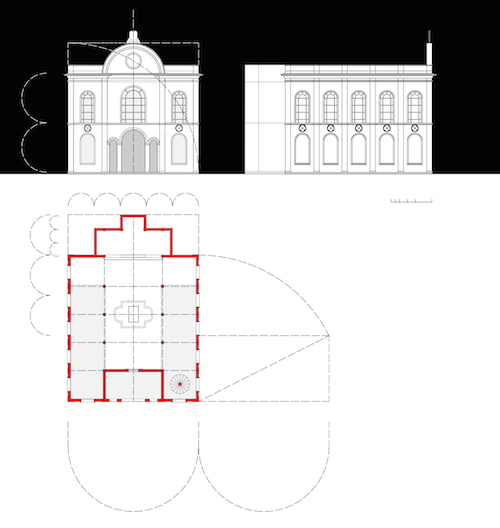
While bearing witness to a phase of cultural transition,93 when the Jewish community was also fraught between tradition (integration into the Ottoman Empire) and innovation (assimilation into French culture), the Beth Saul synagogue reflects a pursuit for modernity and an expression of cultural identity.94 E.N. Adler remarked that:
“at Fakima Modianos (…) Kippur-lights were Europeanized by having donors’ visiting cards neatly attached to them with silk ribbons, as in our way with floral offerings.”95
The Monastirioton synagogue
After the Balkan wars Salonika was incorporated into the Greek State and separated from the territories that had formed its economic hinterland. Despite unease created over the new reality, local and international Jewry soon regarded the Hellenic government with increasing confidence, so much so that Jews from Monastir, Istip and Stroumitza moved to Salonika. It was the fire of 1917 which dealt the Jewish community a blow from which it never recovered: the historic synagogues were destroyed, as well as midrashim and community buildings, the old library of the Talmud Torah and the modern schools of the Alliance Israélite Universelle. According to the 1916 census the Greek population was already prevalent, and became even more so after 1923 when the city received 88,612 Greek-orthodox refugees from Asia Minor.96 The city center was a tabula rasa, and the suburbs were swarming with a new wave of refugees, living in what were little more than wood or tin huts according to their area of origin: Cesme Rysion, Istanbul, Varna, Konya, Izmir.
The Monastirioton synagogue was founded in such turbulent years, with a donation made in 1925 by Ida Aroesti from Monastir in memory of her husband, Isaac, for the Jews from Monastir who had settled in Salonika.97 The synagogue was built in the fire zone, on a plot in the Turkish quarters, now zone V of Hébrard’s reconstruction plan. The new town-planning scheme gave the Greek government an opportunity to “Hellenize” Salonika, making radical changes to the old system of ethno-religious quarters98 by combining principles of urban composition (urban axes of symmetry as functional units, diagonal streets favouring circulation, regular geometrical shapes for squares and open spaces) with a Neo-Byzantine architectural style recalling the city’s pre-Ottoman past.
Close to the site of a large school complex,99 the Monastirioton synagogue was to fit into the newly designed urban blocks along Syngrou Street featuring a neo-Byzantine style, possibly following the aesthetic aspects of the reconstruction plan [Fig.11].
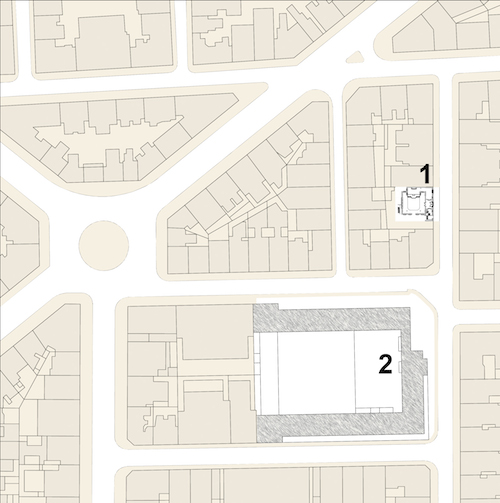
(Authors’ reconstruction).
It was placed at the center of a plot cut out from an urban block, the square prayer hall (16.6 x 16.6 meters) surrounded on two sides by a narrow courtyard and, on the other two, by auxiliary spaces. The fine building designed by the Jewish architect E. Levy combined the four-column type layout with that of the basilica-type: the main longitudinal axis of the prayer hall lay parallel to the street, with four columns dividing the space into a central nave with lateral aisles; the Π-shaped women’s gallery ran along three sides of the hall with graduate benches above the aisles. The main façade on Syngrou Street was divided into three vertical compartments, the central one marked by a recessed porch with three entrance bays and a curved gable as a crowning feature. From the porch, men could gain access to the midrash or to the prayer hall, while women had a separate entrance to the staircase leading to the gallery and reception room on the upper floor [Fig.12]. The tevah and the heikhal formed part of a grand composition: a tribune-like platform which reflected a tradition in Salonika’s synagogues. 100
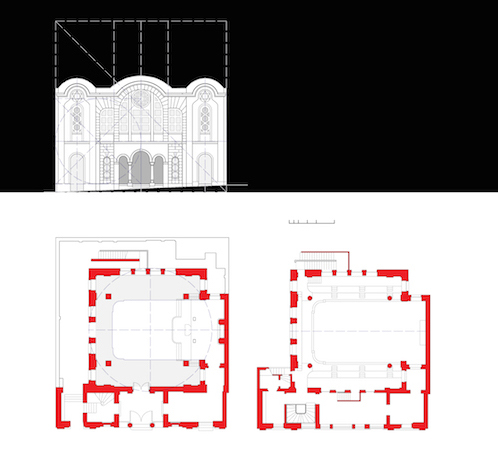
During the German occupation the synagogue was occupied by the Red Cross and was therefore spared. Since destruction of the Beth Saul in 1943, it has served as Salonika’s central synagogue.
BACK
Conclusion
The list of synagogue names may perhaps suffice to show that no question raised by research, even one on architecture, can be answered without considering the complex settlement processes which have led to Salonika being called the city of the Jews,101 or mother of Israel.102 A study of its synagogues therefore raises many questions: firstly, the exceptional nature of this “city of refugees” comes to the fore in the longue durée,103 already a port in its ever-changing anthropological makeup, even before any ad hoc infrastructure had been established.
Other issues concern the way architecture and urban design have played a part in implementing strategies “of eradication and dispossession, erasing one uneasy past to revive another; it may be added that, paradoxically, the radical changes imposed by the reconstruction plan proved the importance of the historic synagogues as documents to the Jewish presence in Ottoman Salonika, expressing as they did a centuries-old “right of citizenship.”
Along this line of thought, one key aspect of this study – certainly worthy of a more scholarly work – indicates the importance of understanding the lost early-Ottoman city, its frequent reconstruction and space-based pluralism.
The topography of synagogues (real and symbolic), the multi-purpose cortijos, or the caravanserai-like Talmud Torah, show some traits of a city where the structural role of architecture has been revealed in the most dramatic of circumstances, completely different from those of the “modern city” merely requiring easy access and a functional spatial organization.
In a regime characterized by a blending of cultures, by interpositions from near and far, even the idea of context presents several aspects. This may be extended to include the institutional set-up, so entirely different from that prevailing in Europe, but also communities of such variety as to make simplification impossible. The idea of context acquires solidity the more we consider the original features of the city, and how these have reacted to exceptional processes of settlement, as in cases where a ceaseless inflow of populations and cultures has taken place.
BACK
NOTE: based of research jointly carried out by the authors, this text has been mainly written by C. Pallini. A. Scaccabarozzi has written paragraphs Salonika Jews before the Ottoman conquest; The Beth Saul synagogue and The Monastirioton synagogue and is the author of many interpretative drawings that form a fundamental part of this research (see captions).
Cristina Pallini is senior researcher at the Department of Architecture Built Environment and Construction Engineering ABC, Politecnico di Milano, teaching Architectural Design at the Faculty of Civil Architecture. She holds a PhD in Architectural Composition (Architecture and City Reconstruction in at Alexandria and Salonika, IUAV, Venice, 2001). Her research has been supported by scholarships from the Italian Research Council, the Greek Scholarship Foundation, the Greek Ministry of Education, the Aga Khan Program at MIT, and the Alexander S. Onassis Foundation. Her key publication include: Pallini & Recalcati, Città porto. Matrici architetture scenari (Milano: Libraccio, 2012); Pallini, “Geographic Theatres, Port Landscapes and Architecture in the Eastern Mediterranean: Salonica, Alexandria, Izmir” in Cities of the Mediterranean, eds. M. Toksoz, B. Kolluoğlu Kirli (London: I.B. Tauris, 2010), 61-77; Pallini & Ferro, Alexandria Beyond the Myth (Boves: ArabaFenice, 2009); Pallini, “Italian Architects and Modern Egypt” in Studies in Architecture, History & Culture (AKPIA@MIT, Cambridge MA, 2006), 39-50.
Annalisa Riccarda Scaccabarozzi (1968) holds a MA degree in Architecture (Politecnico di Milano, 1997) and a PhD in Architectural Composition (IUAV, Venice, 2004). Since 2006 she has been teaching Achitectural Design at the Faculty of Civil Architecture (Politecnico di Milano). Her focus on architectural heritage, planning and landscape dates back to her PhD thesis – a comparative study on the Sacro Monte at Varallo, the Vittoriale at Gardone Riviera, the Scarzuola at Montegabbione – and is fundamental in current research. Her key publication include: Scaccabarozzi, “Gerusalemme sulle Alpi. Progetti per il Sacro Monte di Varallo,” Sacri Monti, 2 (2010): 114-134; Scaccabarozzi “Due Sacri Monti laici: il Vittoriale e la Scarzuola” in L'architettura del Sacro Monte: storia e progetto, eds. I. Balestreri and M. Meriggi (Milano: Libraccio Editore, 2012), 90-105.
DOI: 10.48248/issn.2037-741X/769
